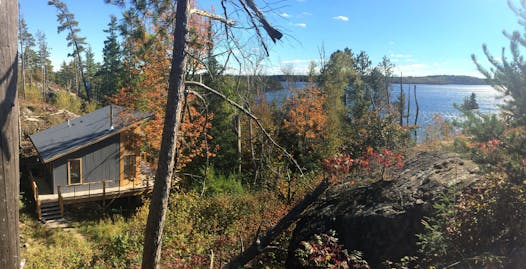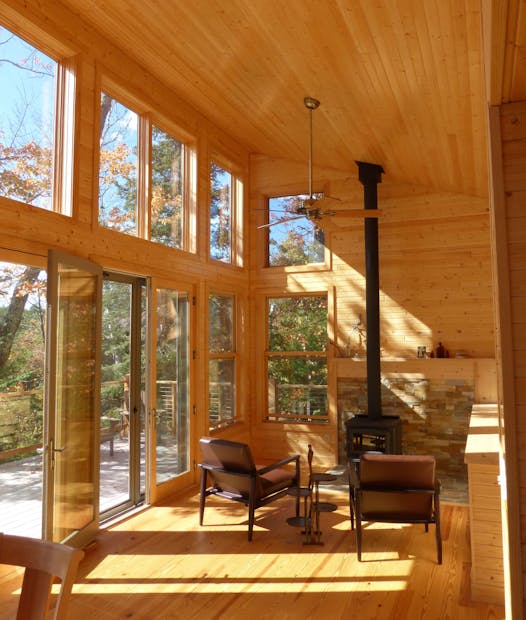Paul Engh and Claudia Kraehling never planned to build a cabin on their remote property on Burntside Lake near Ely in northern Minnesota. Kraehling had a lifelong connection to the area, including the acreage on Ripple Island that she inherited from her mother, Natalie Kraehling. But it took a forest fire and a windstorm to push the couple into finally creating their dream island dwelling.
Kraehling and her sisters grew up vacationing at Camp Van Vac, which was founded by her mother's uncle Van Vacton Harris in 1917. The rustic resort offered 25 log and stone cabins on Burntside Lake. "When I was a kid, it was a magical time," she said. As a teen, she worked at the resort store. After Kraehling and Engh were married, they spent summers in the area with their two children.
In 2002, Kraehling's father, Bud Kraehling, the former WCCO-TV weatherman, divided his estate. He gave Claudia 9 acres on Ripple Island, which her mother had invested in decades before she died in 1998.
The property was mostly rocky terrain and covered a fourth of the island — but it was right across the lake from Camp Van Vac. Although Bud and Natalie Kraehling never built a cabin on the island, they often boated over from the camp to pick blueberries.
"I was happy to carry on my mother's love for the Burntside Lake area," said Kraehling.
For the first few summers, Kraehling and Engh and their two young children simply camped on a wood tent platform that they built atop a rocky bluff surrounded by century-old white pines. Every other weekend, they roughed it with only an outhouse, hauling in food and water.
In 2005, a Ripple Island resident forgot to extinguish a campfire, and almost all of the trees on the couple's acreage were destroyed by a forest fire. Kraehling and Engh raced north to survey the still-smoldering destruction. "I was devastated," recalled Kraehling. "I wouldn't be alive to see those trees again."
So they built a new tent platform and outdoor "biffy" to replace the old ones, which were destroyed. But this time they erected a permanent yurt made of canvas so they wouldn't have to assemble and disassemble a tent on trips to the lake. It wasn't the perfect solution — fewer trees meant less shade, and the yurt was uncomfortably hot in the summer.
Nature struck again on July 4, 2012. The couple and their daughter spent a few days on the island, but left early to go to a parade in the Twin Cities. Straight-line winds hit the area, uprooting the yurt and blowing it down to the shoreline.
"A neighbor called and said, 'Your yurt is gone,' " said Kraehling. "The stakes would have been like spears, and we would have been injured."
After surviving nature's fury of fire and wind, the couple got the message — they needed a strong, permanent structure.
"It was time to build a cabin," said Kraehling. Engh agreed. "If you commit to a piece of land, you have to use it. And when you use it — you have to have a safe place to stay."
The couple enlisted architect Ken Stone, their neighbor and friend for 25 years, to design a simple structure to shelter them from the unpredictable elements.
That fall, they walked the site with Stone and determined that the ideal spot was a shallow valley that offered a spectacular panorama of the lake. Since the cabin was for just the two of them, the couple requested a one-room structure of no more than 600 square feet. A barge would have to haul the supplies and building materials to the site, so less square footage was economical.
"Small is beautiful," said Engh, referring to one of his favorite architecture books, "The Most Beautiful House in the World," by Witold Rybczynski. "It's all about the importance of light and lift in a house."
Stone integrated that philosophy into his design. The cabin's sloped roof is tilted toward the lake, opening up the living areas to the south to capture warmth and sunlight.
"It's such a beautiful site, I wanted to make one simple image of a sloped roof lifting up," said Stone, who works for the firm Kodet Architectural Group in Minneapolis.
The one-room interior evokes a traditional cabin clad in rich knotty pine and warmed by a wood-burning stove. Two sets of French doors open to a 300-square-foot deck, making it feel like a screen porch. Stone made sure the plan included windows on all four sides for cross-ventilation and airflow.
In contrast, the exterior is reminiscent of rural Minnesota outbuildings, with a corrugated metal roof and metal siding on three sides. It's also maintenance-free, economical and easy to install, said Stone.
A single built-in bookcase is the only divider between the sitting room and bedroom. One bathroom is the only enclosed space.
In the far corner, an efficient pocket kitchen has everything the family needs — sink, stove and under-the-counter refrigerator. With floor-to-ceiling expanses of glass, Kraehling said, the three-season cabin is like "living in a treehouse. You wake up with the sun, " she said, "and when there's a full moon it's very bright."
Although the setting feels like the North Woods wilderness, every morning Engh boats over to Burntside Lodge for coffee, a newspaper and groceries. Or he'll guide the canoe along the lake's shoreline.
Kraehling is an artist and sketches plants and wildlife she encounters along the hiking trails. And, of course, there's blueberry picking in July, a family tradition for decades.
For Kraehling, the couple's quiet Ripple Island retreat is where she appreciates and feels a connection to her northern Minnesota heritage. "That piece of land was part of my mother," she said. "I feel her there."
Lynn Underwood • 612-673-7619
@LyUnderwood
4/20 grew from humble roots to marijuana's high holiday





